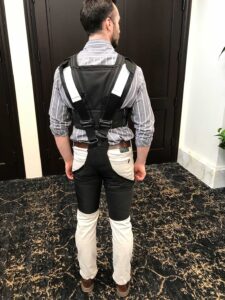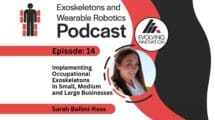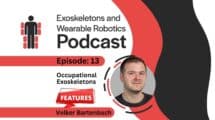Mark Harris, CEO of HeroWear, took the digital stage at WearRAcon 20 to announce the company’s first exoskeleton product, the Apex. The Apex is a fabric-based exosuit designed to assist the back muscles while lifting. The assist can be selectively turned on or off at the control of the user using proprietary technology. Furthermore, the Apex was designed specifically with the intent to fit women as well as men.
The human body has the capability to adapt to a variety of tasks, said CEO Mark Harris during his presentation at WearRAcon20. Importantly, there is a mind behind it that is capable of reacting to complex situations. This combination of physical and mental capabilities makes it likely that people will be working tough and critical jobs for many decades to come. Over time, however, fatigue adds up. Even without physically intensive jobs, most of us will have back pain or a back injury at some point in our lives.
HeroWear has developed a new type of exosuit based on the following principles:
- Do not constrain movement.
- Provide assistance, but only when the user needs it.
The main rationale stems from the idea that for a task-specific exoskeleton, around 90% of the time that task will not be performed and the wearable device just needs to stay out of the way.
The Apex is intended to be a low profile breathable and comfortable device:
- Textile bas
ed: the goal is to forget that you are wearing this device while it blends into the background. Special attention was paid to breathability and heat retention. Workers usually work in non-airconditioned and hot environments. The Apex utilizes patent-pending technology for ventilation and its lack of a front chest plate.
- Passive assistance utilizing elastic materials in parallel with the back muscles. The technology was developed at Vanderbilt (there are several papers published by Dr. Karl Zelik).
- Modular: the Apex is designed to be easy to don and doff with estimated 25-30 seconds to put on and 10 seconds to take off. One size fits all doesn’t work without sacrificing cost, weight or comfort. To solve this, the four main components can be swapped out: back piece, straps, thigh sleeves, and bands. By mixing and matching pieces, the goal is to achieve a 95% fit across most body types.
- Dual-mode: the exosuit’s support can be turned on/off with a switch. This is part of another patent-pending technology. Note that walking in assistive mode is not intended to be a hindrance. Disengaging the clutch removes the tension from the elastic elements, allowing employees to sit, walk, operate a forklift, etc…
The HeroWear Fit Kit has 56 unique fit combinations (that can be ordered together or separately) with the intent for the Apex to fit “like a glove” for male and female employees. The Apex was designed from the beginning with the intent to fit women.
HeroCare360 is a full program on storage, cleaning, maintenance, fit, training protocols and training tools that comes with every unit. There is a very high employee turnover rate in logistics, making it important that the device can fit well (one exo per person, no sharing).
HeroWear hopes that the Apex will be a game-changer for the industry. The current device statistics are 3.4lbs (1.5kg) in weight with the capability to offload the back by 50 pounds with every lift for both male and female workers while preserving their full range of motion and remaining comfortable. The envisioned cost of the device is $1,199 MSRP.
Data and studies are scheduled to be presented on the second day of WearRAcon 20 by Matt Marino.

An early prototype (or spiritual predecessor) of the Apex was introduced at WearRAcon18 as “Mechanisezed Clothing.” It was entered as part of the WearRA Innovation Challenge for that year (link). The design won the fan-favorite based on a vote by all conference attendees.
Left, Erik Lamers from Vanderbilt University posing with the Mechanised Clothing during WearRAcon18.
The Exoskeleton Report team was also fortunate enough to try out the prototype. It was lightweight and the switch mechanism to disengage the elastic element in the back definitely worked as intended.
Note that having elastic elements travel in parallel to the body’s muscles in order to help with lifting is not a new concept, however, having a mechanism to selectively loosen them so a person can move normally makes this an exoskeleton type device.










Great coverage Bobby! 100% Exos should stay out of the way when not needed. Let the user define what it needs to do and when. Can’t wait to try one on.
[…] to serve and protect both women and men. We are thrilled that this research helped lead to the first commercial exosuit or exoskeleton designed with both male- and female-fits ,” Zelik […]